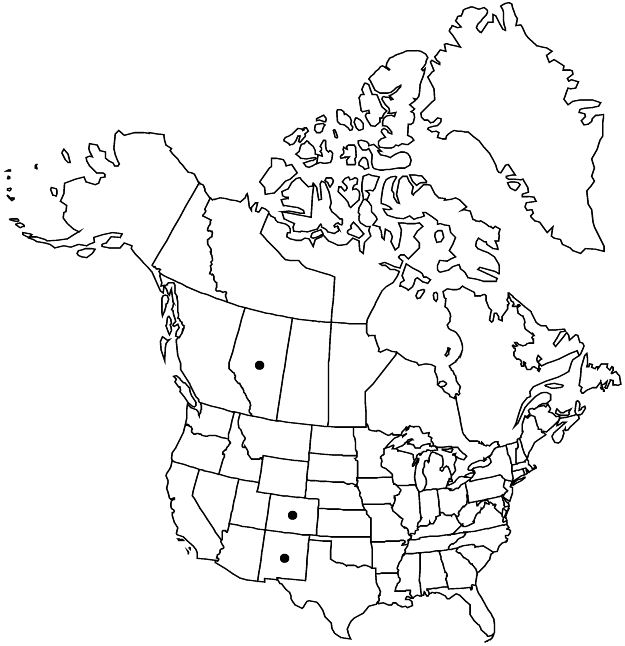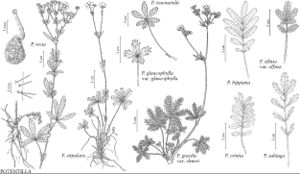Potentilla subjuga
Bull. Torrey Bot. Club 23: 397, plate 274. 1896.
Stems (0.8–) 1–2.5 (–3.5) dm. Basal leaves usually palmate with additional lateral leaflets, sometimes pinnate, 3–10 (–14) cm; petiole 1.5–5 cm, vestiture seasonally dimorphic, long hairs abundant, spreading on first-formed leaves, tightly appressed to ascending on later-formed leaves, 1–2 mm, ± stiff (especially on later-formed leaves), cottony and crisped hairs usually absent, glands absent or sparse; leaflets (3–) 5 at tip of leaf axis plus 1 (–2) additional pair (s) separated from tip by 3–20 mm, on distal 1/10–1/3 (–1/2) of leaf axis, largest leaflets oblanceolate-oblong, (0.5–) 1.5–2.5 (–3) × 0.3–1 cm, ± whole margin incised 1/2–2/3 (–3/4) to midvein, teeth (2–) 4–9 per side, usually touching to strongly overlapping, sometimes separate, 2–6 mm, surfaces usually strongly dissimilar (less so on first-formed leaves), abaxial usually white, straight hairs ± abundant (mostly on veins), 1–2 mm, cottony or crisped/cottony hairs ± dense (sparser on first-formed leaves), glands absent or obscured, adaxial green (to grayish), straight hairs sparse to common, 0.5–1.5 mm, cottony and crisped hairs absent, glands sparse. Cauline leaves 1–3. Inflorescences 3–20 (–30) -flowered. Pedicels 0.5–2 cm (proximal to 3 cm). Flowers: epicalyx bractlets narrowly to broadly lanceolate, 2–5 (–6) × 1–1.5 mm; sepals 4–7 mm, apex acute to acuminate; petals 4–8 × 4–8 mm; filaments (0.5–) 1–2 mm, anthers 0.3–0.8 mm; carpels 15–30, styles filiform to filiform-tapered, ± papillate-swollen in less than proximal 1/5, 1.5–2 mm. Achenes 1.2–1.6 mm.
Phenology: Flowering summer.
Habitat: Alpine tundra and meadows, boulder piles, gravelly slopes, stabilized talus
Elevation: 3400–4000 m
Distribution

Alta., Colo., N.Mex.
Discussion
Potentilla subjuga is centered in the high mountains of Colorado and barely enters New Mexico in the Sangre de Cristo Mountains. Collections from Alberta also apparently belong to this species, but all known collections from Wyoming have been identified as different taxa, at least one currently undescribed. At its most distinctive, P. subjuga is easily recognized by its unique leaf division, with five palmate leaflets subtended by an additional pair (or two) of lateral leaflets. Southern populations, however, are more likely to have only three apical leaflets. The leaflets tend to be strongly bicolored with overlapping teeth, in contrast to most sympatric pinnate species. Petiole vestiture is also distinctive in being seasonally dimorphic, with long hairs on first-formed leaves spreading to ascending and those on later formed leaves tightly appressed, as well as more conspicuously verrucose. Unresolved infraspecific variation exists, and field observations suggest that P. subjuga readily hybridizes with sympatric species, creating a swarm of intermediate specimens.
Selected References
None.
Lower Taxa
"thin" is not a number."dm" is not declared as a valid unit of measurement for this property."-3timesbasalleaves" is not declared as a valid unit of measurement for this property."dm" is not declared as a valid unit of measurement for this property."dm" is not declared as a valid unit of measurement for this property.
